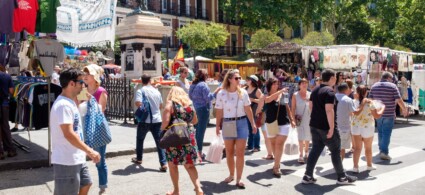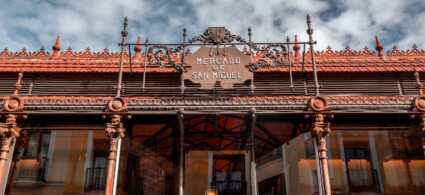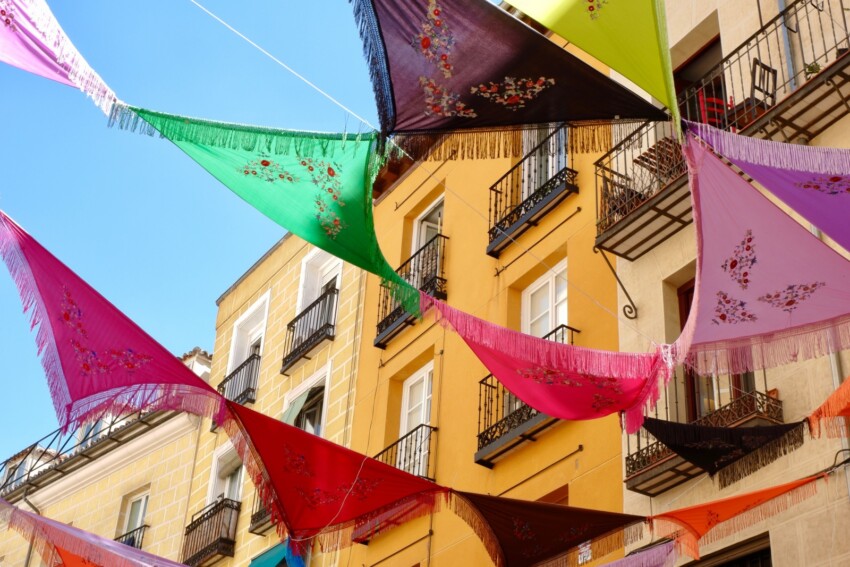

Barrio La Latina is located in the very centre of Madrid and yet seems light years away from the touristy and ‘glossy’ areas of Austrias, Sol and Gran Via.
This popular neighbourhood is one of the most traditional areas of the capital, as its urban conformation of winding medieval alleys and irregularly laid out squares, so different from the grand boulevards of the tourist areas, clearly reveals.
It is the ideal place for those who prefer to drink a cerveza in a traditional tavern than a cocktail in a trendy bar, for those who like to browse the markets rather than shop in boutiques and for those who walk for hours without wondering where to go.
It is also one of the best areas to attend Madrid’s traditional fiestas, such as the Verbena de la Paloma and the Fiesta de San Isidro, during which true Madrileños go wild in typical songs and dances.
If all this were not enough, there is another good reason to include La Latina among the must-see areas in Madrid: here you can eat the best tapas in town. Try the squid sandwich or a portion of paella, accompanied by a ‘cerveza’ of course.
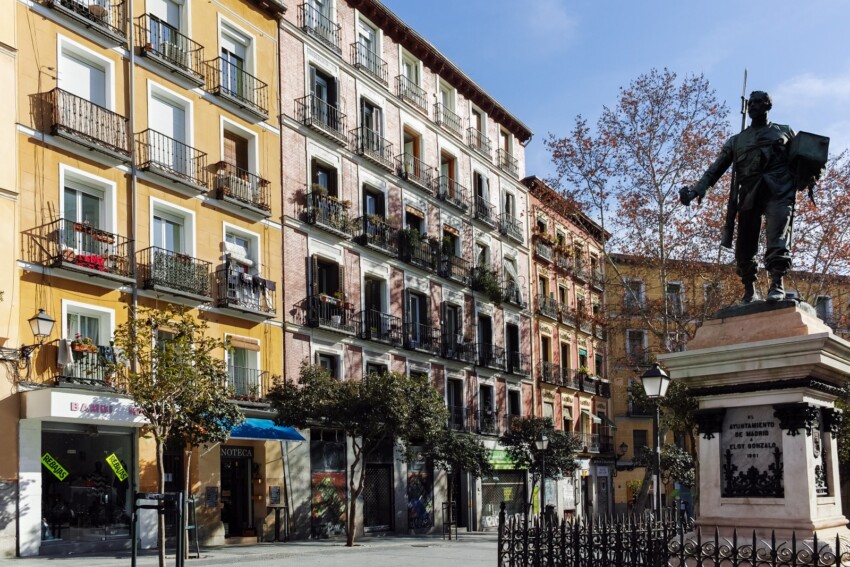
La Latina is one of those neighbourhoods to wander around at random, without an itinerary or a list of attractions to visit. You come here to get a taste of real Madrid life: arm yourself with comfortable shoes and enjoy a walk through one of the most authentic areas of the Spanish capital.
The soul of the district are its squares, popular meeting places for residents. The most famous is the irregularly shaped Plaza de la Cebada, but if you want to get to know the neighbourhood in depth, look for lesser-known squares such as Plaza de La Paja, Plaza del Humilladero, Plaza de San Andrés and Plaza de Puerta Cerrada.
They change their appearance completely at different times of day: in the early morning, almost completely deserted, they have a romantic charm; they gradually come alive until they explode with people from aperitif time onwards.
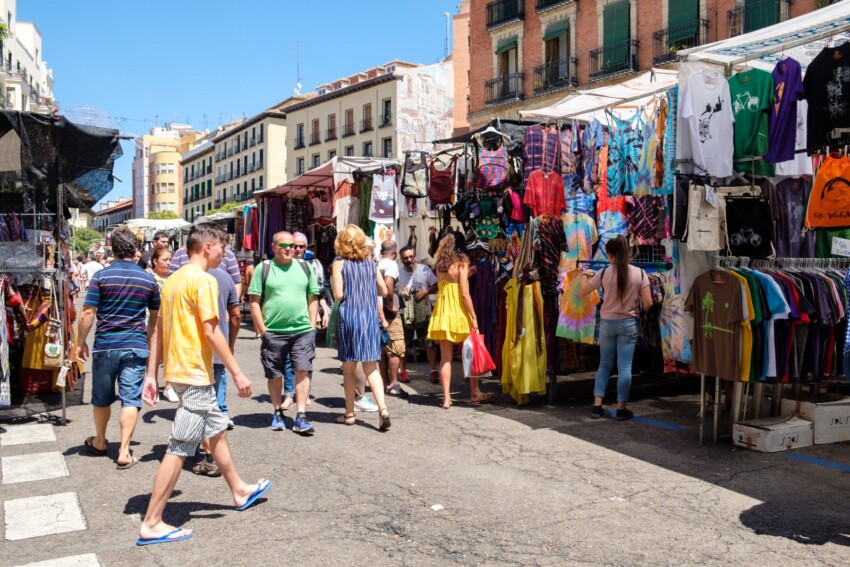
The district’s big attraction is the Mercato del Rastro, Madrid’s most famous and crowded market. It takes place every Sunday and on public holidays. The original core is located in Plaza Cascorro and neighbouring streets, but over the years the market has expanded enormously, in a very irregular way, and it is difficult to list all the streets occupied by vendors.
Born as a second-hand market, today it has more than 1000 stalls where you can buy both second-hand and new items. The atmosphere of this market is very special and definitely worth a visit.
Another famous market held in the barrio La Latina is that of San Miguel. This is a traditional indoor market, the only one with iron structures still preserved. Renovated with modern taste, it is now a gourmet paradise where you can buy and taste high-quality food products; it is also an occasional concert venue.
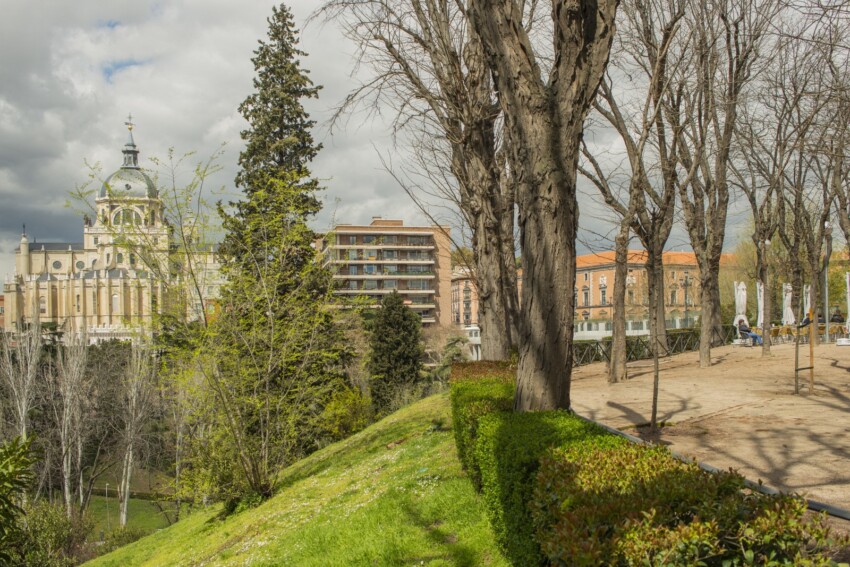
If bargaining with the street vendors has exhausted you, go for a rest at Parque de las Vistillas, an oasis of greenery with trees, fountains, statues, turf beds and granite paths.
Virtually unknown to tourists, these two-tiered gardens are, on the other hand, much loved by Madrileños. We suggest you visit at sunset because the sunset seen from the park with the Almudena Cathedral in the background is particularly impressive.
During your stroll through La Latina, check out the Real Basilica de San Francisco el Grande, an 18th-century basilica boasting one of the largest domes in Europe and an interesting museum with a collection of paintings from the 17th to the 19th century.
The nightlife in La Latina is not as wild and transgressive as in Chueca, nor can it boast the alternative, underground ambience of Malasaña. Remember, though, that you are in Madrid, the city that always stays late, and even a traditional neighbourhood like La Latina gets crowded at night.
It is not the best choice if you are into trendy bars or live music venues, but it is the place to be if you want to enjoy a cerveza. At weekends, expect to have to scramble to order a beer at the bar counter.
Accommodations in La Latina is scattered all over, but you’ll find a greater concentration in the slice of the neighbourhood from Plaza del Humilladero to Calle de la Cava Alta and Calle de la Cava Baja. It is not an area where silence reigns supreme, as there are several bars, clubs and restaurants, but you will nevertheless experience the true soul of the neighbourhood, while also remaining connected to the rest of Madrid, as the La Latina metro stop is just a few steps away.
The La Latina neighbourhood is located southwest of the historical centre. There are two convenient metro stops to reach it, both on line 5.
One is Puerta de Toledo, but bear in mind that it is at its southern end, so to get to its heart, which coincides with Los Carros and Humilladero squares, you’ll have to walk a few hundred metres once you get off. The second is the one called La Latina itself, located at the eastern end of the district, which is much more conveniently located in Plaza de la Cebada next to Teatro La Latina.
Like many other central districts in Madrid, La Latina owes its name to a historical figure: in this case, the writer and humanist Beatriz Galindo, who lived between the 15th and 16th centuries.
She went down in history as La Latina because of her passion for the classics. She was the tutor to the children of Queen Isabella the Catholic and one of the first women in the world to hold the post of university professor.
In addition to the madrileño quarter, a crater on the planet Venus has been dedicated to her.
La Latina is located in the centre of Madrid, in what was once the outskirts of the old city, with the main streets branching off from Plaza de la Cebada and Plaza de Paja. It can be reached by metro lines L1, L3, L5.
City Card allow you to save on public transport and / or on the entrances to the main tourist attractions.

